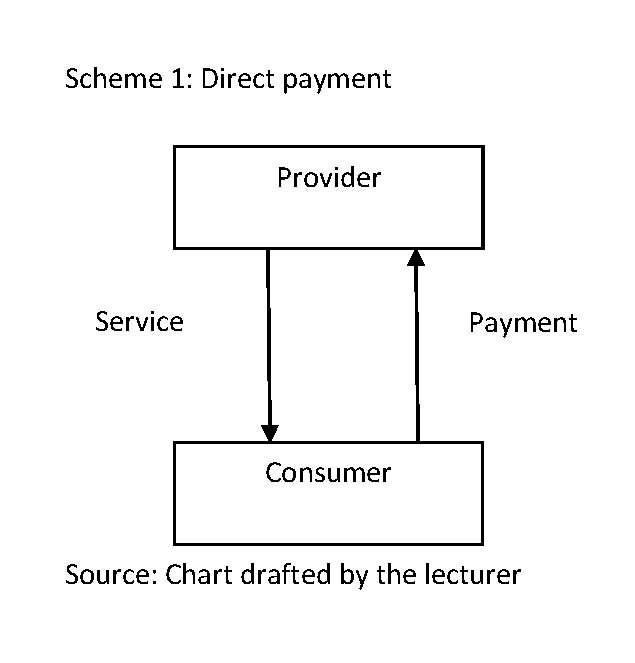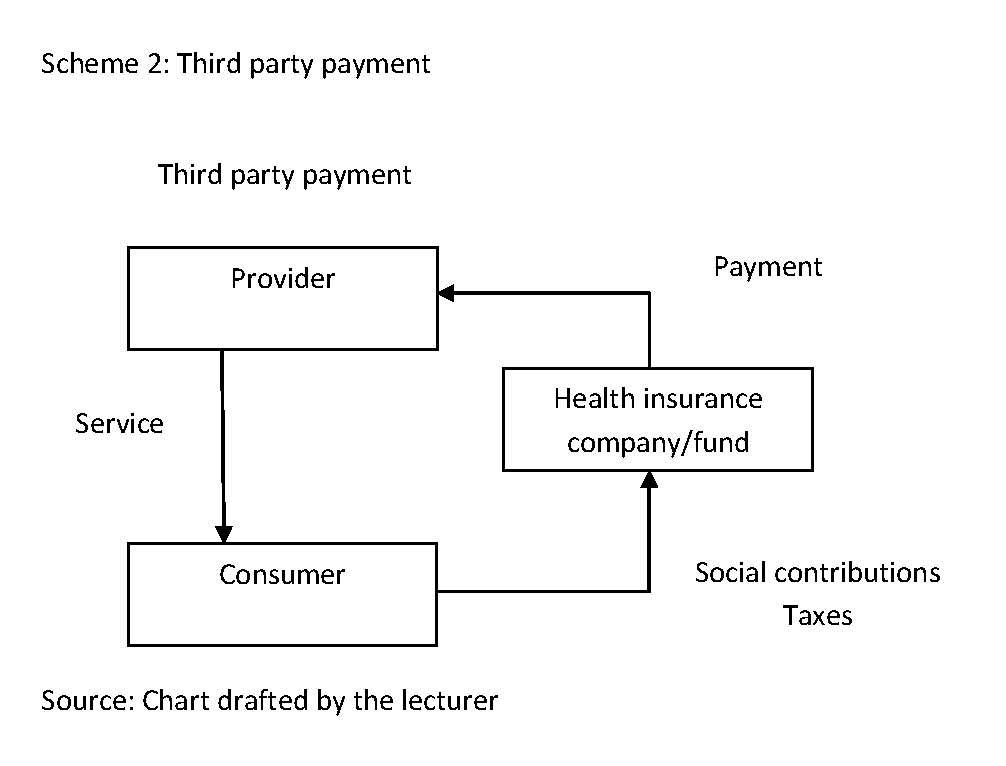1. What is a third party payment?
In the second lecture I mentioned that people prefer consumption of healthcare services over maintaining their good health status, because the benefit from consuming healthcare services are obvious, while costs are hidden. This is due to the existence of health insurance and due to payments by a third party.
In case of direct payments, the consumer pays the whole amount of resources for services directly to the provider of those services. However, in case of third party payments for healthcare services, it is the health insurance company that pays for us. Thus, the consumer is isolated from being informed about the real costs of healthcare services. And this fact makes people think healthcare is free of charge.
2. What is a direct payment?
In this case, the consumer pays directly to the service provider. He/she receives healthcare services for his/her money. Such costs compete directly with other expenditures of households.

3. What is a third party payment?
In this case, health insurance company covers the costs instead of the consumer and pays for the services to the service provider. Thus, consumers consider these services as free of charge.

4. How much money flows through third parties in the Slovak healthcare system?
Health insurance companies make yearly third party payments for about 3.5 billion Euros in total. These are payments to general practitioners, specialists, hospitals, for medicines, or laboratory and diagnostic services.
In order to make these payments by health insurance companies happen, economically active people pay regularly social contributions to the health insurance company. For economically inactive people (retired people, students, women on maternity leave etc.), the state pays these obligations to the health insurance companies.
Direct payments reach approximately 1.3 billion Euros per year. These are, however, not part of the health insurance scheme. They relate to co-payments for medicines, or payments to private healthcare providers, as well as informal payments.
5. Disadvantages of third party payments
In respect to the perception of healthcare services that are free of charge, the greatest disadvantage of third party payments is wasting resource. It takes more forms and it leads towards a higher consumption of healthcare services and consequently to higher costs for healthcare.
Moral hazard – it is a risky behavior caused by the fact that the person taking the risk does bear the costs of his/her behavior.
For instance, an extreme skier can rely on the fact that in case of a serious injury, the health insurance company will pay his/her costs for treatment. Or in case of a heavy smoker, he/she relies on the health insurance company that will pay for his/her lung cancer treatments.
Supplier induced demand – the consumer utilizes healthcare services based on doctor’s recommendation as a consequence of information asymmetry. Information asymmetry is a situation, when we assume that the provider of services has more information about diagnostic and treatment methods. As a matter of fact, the doctor does not take the responsibility for costs induced like this and he/she may recommend a consumption of unnecessary healthcare services.
For instance, additional laboratory and diagnostic tests, which do not make any progress in the decision-making of the provider.
Consumption of healthcare services with no value added for the consumer. In respect to third party payments, consumers may use healthcare services, which have no value added for them, what is more, they may be even harmful to them (negative benefit).
For instance, diagnostic treatments (such as CT or MRI) asked by the consumer with high radiation burden, which he/she would not ask for in case of direct payments.
Over-consumption of healthcare services – Services, which are „free of charge”, cause a consumption of healthcare services, which he/she would not utilize under standard circumstances (because they are paid by the health insurance company).
For instance, unnecessary medication prescribed and consumed.
6. Advantages of third party payments
Financial protection – the ability to financially cover high cost and chronic risks. This means that the person is not confronted with high financial costs when consuming healthcare services.
For instance, costs for one dialyzed patient are around 23 500 Euro per year in Slovakia. Third party payment means that the health insurance company pays this amount instead of the patient.
Redistribution of accumulated funds – transfer of resources from patients with low cost treatments to patients with treatments with higher costs. Redistribution is the better, the more the system is able to predict risks and allocate resources correctly between particular health insurance companies.
For instance, since 1 July 2012 in Slovakia, redistribution mechanisms take into consideration not only the age, gender and economic activity of the patient, but also PCG (risk adjustment system based on former consumption of medicines).
Third party payments enable risk management of chronic diseases through resource accumulation. If conditions are set correctly, the system enables competition between health insurance companies based on various health plans for various patient target groups. Health insurance companies have the chance to create products (insurance plans) according to the preferences of consumers, and so to manage the risk of chronic diseases.
For instance creating insurance products for diabetes or asthmatics.
7. What is the effect of healthcare systems that are „free of charge“ on expenditures and on the health status of people?
This question has been answered by a massive experiment called RAND, which was accomplished between 1974 and 1982 in the USA on a sample of 7 700 people younger than 65 living in 6 different US cities. People were differentiated to those, who received healthcare services „free of charge“ and those, who had to co-finance these services. Both groups had the same doctors as disposal.
Conclusions:
- Healthcare that is „free of charge“ has almost no identified positive effects on the health status of people in comparison to those, who had to co-finance healthcare treatments.
- People with „free of charge“ care consumed 30% to 40% more healthcare services and despite of it, they were not healthier in a 3 to 5 years long period than people, who had to co-finance their healthcare services with direct cash payments.
Conclusion
1. Third party payment means that the consumer is isolated from the costs for healthcare services.
2. Disadvantages of third party payments – moral hazard, supplier induced demand, consumption of healthcare service with no added value for the consumer, over-consumption of healthcare services.
3. Advantages of third party payments – financial protection, risk adjustment through redistribution, (the chance) to manage risks of chronic diseases (with an appropriate adjustment of the competition environment).
4. According to the RAND study:
- Healthcare that is „free of charge“ has almost no identified positive effects on the health status of people in comparison to those, who had to co-finance their healthcare services
- People with „free of charge“ care consumed 30% to 40% more healthcare services and despite of it, they were not healthier in a 3 to 5 years long period than people, who had to co-finance their healthcare services with direct cash payments.
Recommended bibliography
Rand Health Insurance Experiment









Comments
There no comments, yet.